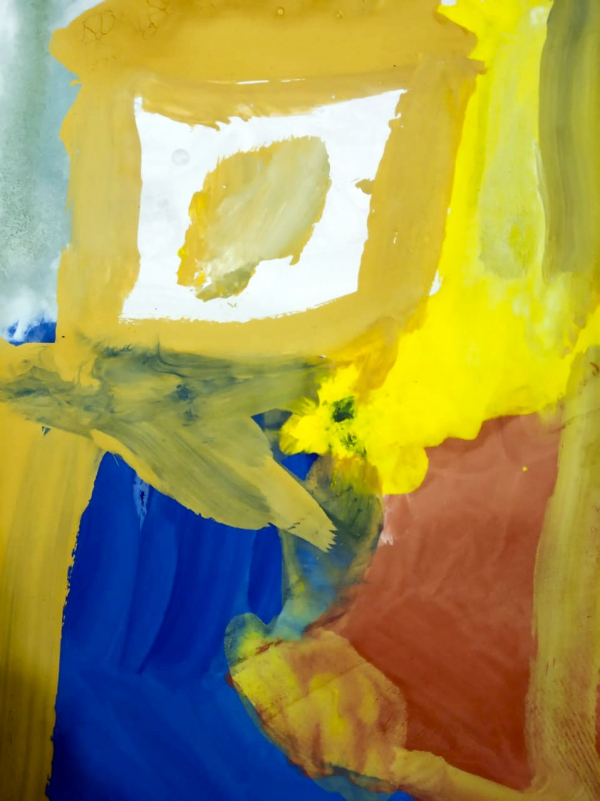By Sajeeb Sarker
Abstract Art
Media School July 27, 2020

`A Girl in Rest`, while in partial abstraction from reality. Artist: Souvik Ayan (2020)
Abstract Art is a particular form of art (e.g. painting, sculpture, or graphic art) which is not an analogous portrayal of things from the visible world that is how things are in reality. In art, this abstraction indicates a departure, an exodus from reality in depiction of imagery. In abstract art, this departure from accurate representation of reality can be slight, partial, or complete. Abstract artists create simplified objection with little or no reference to the 'real' world.
In abstract art, visual language (e.g. shape, form, color, line, tone, texture, and scale are used to create a composition which represents a phenomenon that necessarily does not correspond with visual references in the real world.
The abstraction, in abstract art, factually means the distancing of an idea from objective referents i.e. how a thing is in its objective reality. Thus, in the visual arts, depicting phenomena factually differing from any literal or representational reference points are created by the process of abstraction. This is a major motive for referring abstract art as 'non-objective art', 'non-figurative art', or 'non-representational art'. But to some, the terms are similar, but perhaps, these terms do not carry identical meaning.
Many abstract artists prefer to call it 'concrete art' because of this 'pure' abstraction. Also, to some extent, concrete art is rather considered by many as an abstract art that is entirely free of any basis in observed reality and that has no symbolic meaning.
In other words, abstract art does not represent a person, place, or thing as it is in the natural world. Rather, the subject of the work is what a viewer or an audience (reader) sees: abstract art gives the audience the autonomy to see and explain the color, shapes, brushstrokes, size, and scale including other elements to make a meaning out of it of the reader's own.
It is a significant feature of abstract artists that they strive to be non-objective and non-representational while allowing the viewers to interpret an artwork's meaning in their own way.
Abstract art is often considered by artists and art theorists to be carrying a moral dimension that can be seen as to stand for virtues like order, purity, simplicity and spirituality.
As we understand, abstraction means to separate or withdraw something from something else. And when we apply this logic to (abstract) art, this abstraction is performed on basis of an object, figure or landscape, simplification, schematization etc. to separate the artwork from how the subject of that particular artwork is in the real world.
At present, abstract art has taken many forms: two-dimensional and three-dimensional. Also, abstract art can be vast or small, can be made with many materials and on many surfaces. Modern abstract art was completely radical in its early days after this art form was born in the early years of 20th century. Since the early 1900s, abstract art has formed a central stream of modern art gradually becoming a major interest of many master artists of all time.
Major Abstract Artists
Many artists contributed in shaping the concept of abstract art. The very first artist to create an example of what we call abstract art today is not surely known, however, Russian painter and art theorist Wassily Kandinsky (Wassily Wassilyevich Kandinsky: 1866–1944) is generally credited as the pioneer of abstract art. Art historians often credit Kandinsky for creating paintings of floating, nonrepresentational forms as early as 1912.
As said before, many artists have contributed in establishing abstract art as an independent and powerful art form. To name a few of the foremost abstract artists will include the following names among many others:
- Vasily Kandinsky (1866–1944)
- Piet Mondrian (1872–1944)
- Pablo Picasso (1881-1973)
- Kazimir Malevich (1878–1935)
- Robert Delaunay (1885 –1941)
- Lyubov Popova (1889–1924)
- Mark Rothko (1903-1966)
- Jackson Pollock (1912–1956)
- Agnes Martin (1912–2004)
- Joan Mitchell (1925–1992)
- Ellsworth Kelly (1923–2015)
- Bridget Riley (b. 1931)
- Raymond Duchamp-Villon (1876-1918)
- Constantin Brancusi (1876-1957)
- Andre Derain (1880-1954)
- Sophie Taeuber-Arp (1889-1943)
- Anish Kapoor (b.1954)
References and useful readings
Arnheim, Rudolph (1969). Visual Thinking, University of California Press. ISBN 0-520-01871-0.
Gooding, Mel (2001). Abstract Art. Movements in Modern Art series. Tate Publishing. ISBN 978-1-85437-302-1.
Gray, Camilla (1962). The Russian Experiment in Art (1863–1922). Thames and Hudson.
Kepes, György (1966). Sign, Image and Symbol. Studio Vista, London.
Rump, Gerhard Charles (1985). How to look at an abstract painting. Inter Nationes.
Stangos, Nikos, ed. (1981). Concepts of Modern Art. Thames and Hudson. ISBN 978-0-500-20186-2.
Online articles
Abstract Art – What Is Abstract Art or Abstract Painting. Retrieved on 26 July 2020. [Painting.about.com.]
Themes in American Art – Abstraction. Retrieved on 25 July 2020. [Nga.gov. 2000-07-27.]


